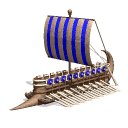Civilopedia entry:
#RACE_ILLYRIANS
^The Illyrians are $LINK<seafaring and agricultural=GCON_Strengths>. They start the game with $LINK<Pottery=TECH_Pottery> and $LINK<Alphabet=TECH_Alphabet> and build $LINK<lembi=PRTO_Lembi> instead of $LINK<galleys=PRTO_Galley>.
^
^The Illyrians may have appeared in the western part of the Balkan Peninsula about 1000 BC, a period coinciding with the end of the Bronze Age and beginning of the Iron Age. For at least the next millennium, they occupied lands extending from the Danube, Sava, and Morava rivers to the Adriatic Sea and the ar Mountains. The area had initially been settled by two groups that would later be known as the Pannonians and the Dalmatians. At various times, groups of Illyrians migrated over land and sea into Italy. The Illyrians
carried out both commerce and warfare with their neighbours.
^The ancient Macedonians probably had some Illyrian roots, but under Philip of Macedon their ruling class adopted Greek cultural characteristics. The Illyrians also mingled with the Thracians in adjoining lands on the east. In the south and along the Adriatic coast, the Illyrians were heavily influenced by the Greeks, who founded trading colonies there. The present-day city
of Durrës evolved from a Greek colony known as Epidamnos, which was founded at the end of the 7th century BC Another famous Greek colony, Apollonia, arose between Durrës and the port city of Vlorë.
^The Illyrians produced and traded cattle, horses, agricultural goods, and wares fashioned from locally-mined copper and iron. Feuds and warfare were constant facts of life for the Illyrian tribes, and Illyrian pirates plagued shipping on the Adriatic Sea. Councils of elders chose the chieftains who headed each of the numerous Illyrian tribes. From time to time, local chieftains extended their rule over other tribes and formed short-lived kingdoms. During the 5th century BC, a well-developed Illyrian population centre existed as far north as the upper Sava River valley in what is now Slovenia. Illyrian friezes discovered near the present-day Slovenian city of Ljubljana depict ritual sacrifices, feasts, battles, sporting events, and other activities.
^The Illyrian kingdom of Bardhyllus became a formidable local power in the 4th century BC. In 359 BC, King Perdiccas III of Macedonia was killed by attacking Illyrians. In 358 BC, however, Macedonia's Philip II, the father of Alexander the Great, defeated the Illyrians and assumed control of their territory as far as Lake Ohrid. Alexander himself routed the forces of the Illyrian chieftain Clitus in 335 BC, and Illyrian tribal leaders and soldiers accompanied Alexander on his conquest of Persia.
#DESC_RACE_ILLYRIANS
^
^After Alexander's death in 323 BC, independent Illyrian kingdoms again arose. In 312 BC, King Glaucius expelled the Greeks from Durrës. By the end of the third century, an Illyrian kingdom based near what is now the Albanian city of Shkodër controlled parts of northern Albania, Montenegro, and Herzegovina. Under Queen Teuta, Illyrians attacked Roman merchant vessels plying the Adriatic Sea and gave Rome an excuse to invade the Balkans.
^In the Illyrian Wars of 229 BC and 219 BC, Rome overran the Illyrian settlements in the Neretva river valley and suppressed the piracy that had made the Adriatic unsafe. In 180 BC, the Dalmatians declared themselves independent of the Illyrian king Gentius, who kept his capital at Skodra (Shkoder). The Romans made new gains in 168 BC, and Roman forces captured Gentius at Shkoder, which they called Scodra, and brought him to Rome in 165 BC. A century later, Julius Caesar and his rival Pompey fought their decisive battle near Durrës (Dyrrachium). Rome finally subjugated recalcitrant Illyrian tribes in the western Balkans during the reign of Emperor Tiberius in 9 AD, and established the province of Illyricum, governed by an Imperial legate. The Romans divided the lands that make up present-day Albania among the provinces of Macedonia, Dalmatia, and Epirus.
^For about four centuries, Roman rule brought the Illyrian-populated lands economic and cultural advancement and ended most of the enervating clashes among local tribes. The Illyrian mountain clansmen retained
local authority but pledged allegiance to the emperor and acknowledged the authority of his envoys. The Romans established numerous military camps and colonies but complete latinization was confined to the coastal cities.
^Illyrians distinguished themselves as warriors in the Roman legions and made up a significant portion of the Praetorian Guard. Several of the Roman emperors were of Illyrian origin. They included Diocletian (284-305), Constantine the Great (324-337) and Justinian (527-565).
^The name "Illyria" went out of use after the division of the Roman empire under Diocletian. It was revived by Napoleon for the 'Provinces of Illyria' that were incorporated into the French Empire from 1809 to 1813, and the
'Kingdom of Illyria' was part of Austria until 1849, after which time it was not used in the reorganised Austro-Hungarian Empire.





 !
! .
. Thats why I made that thankyou thread awile back.
Thats why I made that thankyou thread awile back.  .
. .
. .
. 

